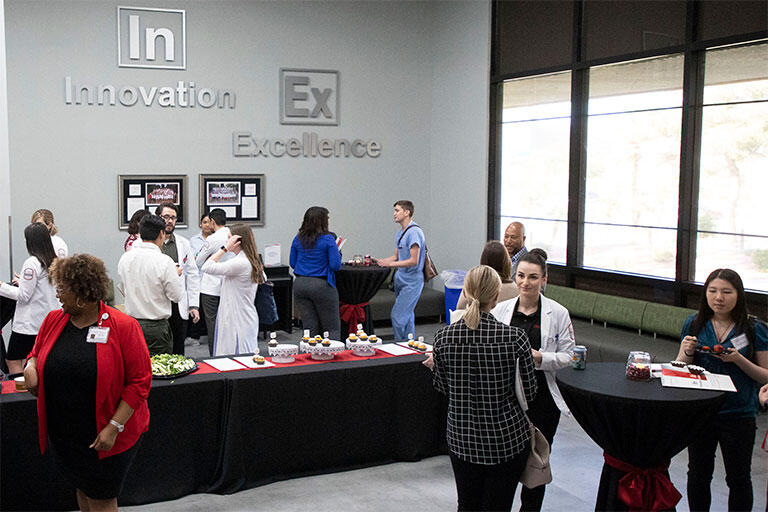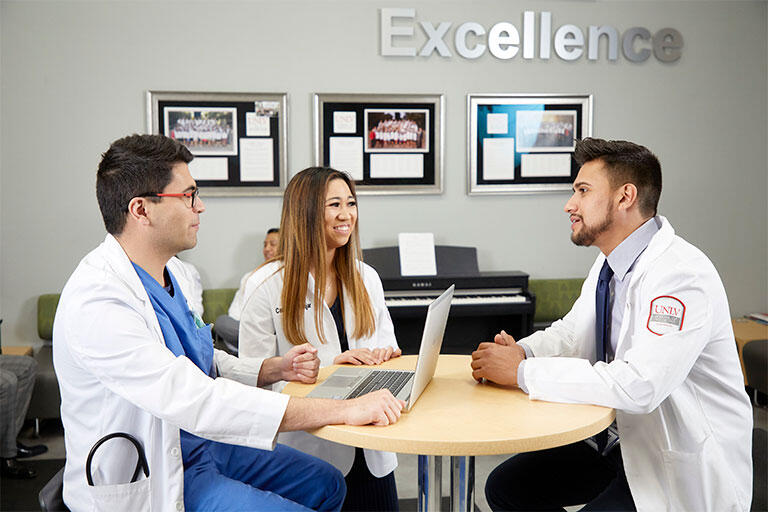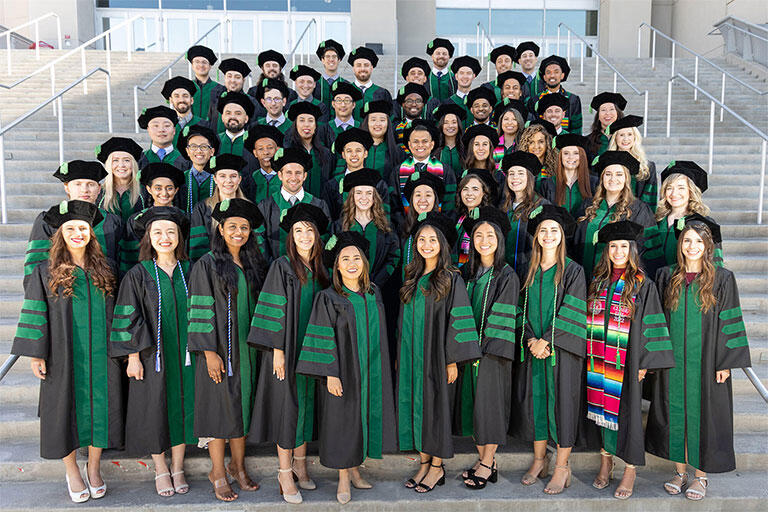About Our Program
The fully accredited doctor of medicine (MD) program at the Kirk Kerkorian School of Medicine at UNLV is rooted in relationships, between faculty and students, physicians and patients, school and community. The basic mission is simple: to educate physicians who will improve the health of Nevadans. On a deeper level, this means recruiting a diverse and talented student body that reflects the community it will one day serve.
The four-year experience is divided into three phases of study - foundations, clerkships, and career exploration - and approaches training and education in a way that will provide graduates with the comprehensive knowledge and skills necessary to meet the ever-changing needs of patients. Our curriculum also helps students navigate new technologies and advancements in medicine. We focus on small-group learning while having a highly dedicated administration, faculty, and staff that focus on continuous improvement and provide comprehensive student support.
What Makes Us Distinctive
Immersion and Public Health
Students begin their studies immersed in the community by going through emergency response training and studying population health. Students become proficient in how to respond to basic emergencies, while learning about the communities they will serve. They also gain interprofessional experiences with first-responders.
Community Service
Service learning is rooted in the school's mission. Cohort-based learning communities perform service hours at some of Las Vegas' largest non-profit organizations and also spend time volunteering at the UNLV Community Clinic in collaboration with Volunteers in Medicine of Southern Nevada (VMSN). Accompanying curriculum also looks at disparities and current topics in healthcare systems in order to provide for patients, especially those in underserved areas.
Basic Science Foundations & Problem-Based Learning
Phase I studies take students through the organ system blocks while integrating self-directed and lifelong learning techniques. Application of the basic sciences is complemented by problem-based and team-based learning where small groups of students undertake an intensive exploration of patient cases that simulate the real-life processes of being a physician on a healthcare team.
Anatomical Education
The virtual anatomy lab and an on-site cadaver lab provide integrated anatomical education. Prosection during Phase I and dissection during Phases II and III enhance basic science and clinical study. Students also have access to plastinated specimens of the human body.
Simulation Training
In Phase I, students participate in simulated training by going through high-fidelity simulator exercises and standardized patient (actor) scenarios. These experiences provide a strong foundation prior to students going into clerkships and specialty electives. Additional skills labs are also conducted in Phase II and III to complement clinical education.
Clinical Training
Students spend dedicated blocks of time rotating in six core specialties (internal medicine, family medicine, pediatrics, obstetrics and gynecology, surgery, and psychiatry) at our teaching hospitals during the Phase II clerkship phase. Training is led by faculty physicians and residents. Students can then continue their clinical training by doing specialty electives locally and nationwide through the Visiting Student Learning Opportunities (VSLO) program in Phase III.
Testing and Academic Standards
Students' levels of knowledge, skill, and aptitude are measured using National Board of Medical Examiners (NBME) question banks and United States Medical Licensing Examination (USMLE) resources and programs. Our dedicated academic support office works with students to prepare them for school and national exam milestones, such as Step 1 and Step 2, while also helping students build individualized study plans and identify the best study resources.
Research
The fundamentals of research and scientific inquiry are taught in Phase I and students can utilize school resources to self-advance their interests in clinical, community, or bench research. Support is also available for regional and national presentation opportunities or to publish. Each year the Kirk Kerkorian School of Medicine also hosts a research symposium.
Additional Study Areas
Threaded throughout the program are specialty studies such as: physicianship, professionalism, ethics, nutrition, integrative medicine, well-being, epidemiology, bioethics, legal issues in medicine, medical tourism, and rural medicine.
School Highlights
- A 135,000 square-foot new educational facility featuring state-of-the art technologies in the heart of the Las Vegas medical district
- Dedicated student life services focused on academic success, career, and well-being
- Robust student life with clubs, regional and national organizations, and student government
- Honors opportunities with Alpha Omega Alpha and the Gold Humanism Honor Society
- Dedicated and esteemed teaching partners: University Medical Center of Southern Nevada (UMC), Sunrise Hospital, Mike O'Callaghan Military Medical Center at Nellis Air Force Base, the Southern Nevada VA Medical Center, and UNLV Health
- Learning Communities designed to facilitate peer support, educational teams, and advanced personal/professional development skills
- Dual degree opportunities: MD/MBA and MD/MPH
Summary of our Training Phases
Factual knowledge is necessary but not sufficient for competent medical practice today. A solid curriculum is one that provides students the opportunity and impetus to learn how to think, how to act, and how to embark on lifelong learning in a self-directed manner. One component of the first curricular phase is problem-based learning (PBL), where students undertake intensive exploration of patient cases that simulate the real-life processes of being a practicing physician. Basic science instruction is also presented through other methodologies, such as team-based learning (TBL). Active engagement is crucial.
Students also take on the equally important tasks of developing new roots in the community through service learning. Students learn the basic practical skills of being a doctor, and hone analytic skills in hands-on sessions in the simulation center. A scholarly project is initiated during this phase, which provides students a first-hand experience with the scientific method under faculty guidance.
The Kirk Kerkorian School of Medicine at UNLV’s clinical curriculum covers the core disciplines: family medicine, internal medicine, neurology, obstetrics/gynecology, pediatrics, psychiatry, and surgery. In addition, students have six weeks of “selectives,” where they can explore other specialties of interest. Upon completion of each core discipline, students take the summative subject examination. At the end of the year, students have command of an enormous fund of knowledge, which positions them for exceptional performance on the United States Medical Licensing Examination (USMLE) Step 2 clinical knowledge (CK) exam. Students have extensive exposure to different areas of medicine to formulate a career choice.
When graduation appears on the horizon, medical students become focused on three essential goals: (1) settling on a specialty of choice, (2) assembling a competitive application for the residency match, and (3) preparing to take on a new level of responsibility as newly minted physicians.
The final phase of the curriculum balances core educational needs with the flexibility that students need at this stage. Students are required to take a sub-internship in a specialty of their choice or a rotation in the intensive care unit. Additionally, students are required to complete Nevada community medicine rotation and Capstone. The remainder of the year consists of electives, with ample unscheduled time to permit residency interviews, research, additional educational experiences, and perhaps some well-earned time-off.
For more information, including course descriptions, view our MD Program Sequence 2025-26 by Semester.




